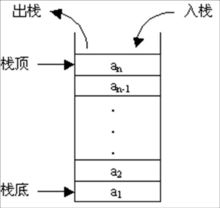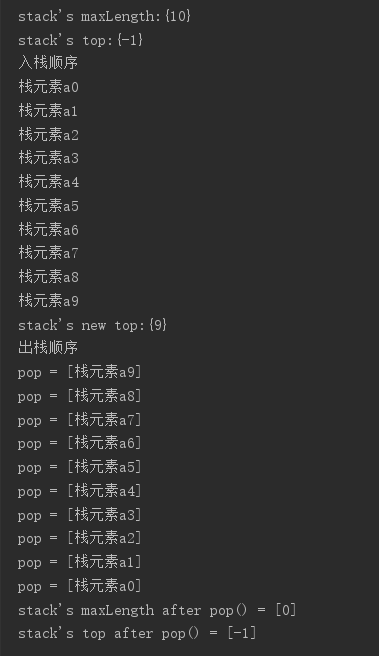栈简介:
栈(stack)是一种运算受限的线性表。限定仅在表尾进行插入和删除操作的线性表。这一端被称为栈顶,相对地,把另一端称为栈底。对于栈结构存储的对象,都遵循“先进后出,后进先出”的原则。
原型类似于像一个圆桶里放与桶半径稍小一点的圆饼一样,先放入(入栈)的圆饼必然里桶底(栈底)较近,取出时必须将从桶面(栈顶)的圆饼先取出(出栈)才能拿到其他圆饼
栈示意图
基于JAVA的String数组模拟栈结构的操作
package stack;/*** @ClassName StackForArray* @Description String数组模拟栈,伪删除效果* @Author Vision* @Date 2019/7/1821:19* @Version 1.0.0*/public class StackForArray {public static void main(String[] args) {Stack stack = new Stack(10);int length = stack.getMaxLength();System.out.printf("stack's maxLength:{%d} \n", stack.getMaxLength());System.out.printf("stack's top:{%d}\n", stack.getTop());System.out.println("入栈顺序");for (int i = 0; i < length; i++) {String str = "栈元素a" + i;stack.push(str);System.out.println(str);}System.out.printf("stack's new top:{%d}\n", stack.getTop());System.out.println("出栈顺序");for (int i = 0; i < length; i++) {System.out.println("pop = [" + stack.pop() + "]");}System.out.println("stack's maxLength after pop() = [" + stack.getMaxLength() + "]");System.out.println("stack's top after pop() = [" + stack.getTop() + "]");}}/*** 栈对象*/class Stack {/*** 数组*/private String[] str;/*** 栈顶指针*/private int top;/*** 栈空间*/private int maxLength;public Stack() {this.top = -1;}public Stack(int num) {if (num > 0) {this.str = new String[num];this.top = -1;this.maxLength = num;} else {throw new RuntimeException("栈大小不能为0");}}/*** 入栈** @param str*/public void push(String str) {if (isEmpty()) {throw new RuntimeException("栈为空");} else if (isFull()) {throw new RuntimeException("满栈");} else {this.str[++top] = str;}}/*** 出栈** @return*/public String pop() {if (isEmpty()) {throw new RuntimeException("栈为空");} else {String str = this.str[top--];/* 伪删除 */this.str[top + 1] = null;this.maxLength--;return str;}}/*** 判断是否为空栈** @return*/public boolean isEmpty() {return this.maxLength == 0;}/*** 判断是否满栈** @return*/public boolean isFull() {return this.top == this.maxLength - 1;}public String[] getStr() {return str;}public int getTop() {return top;}public void setStr(String[] str) {this.str = str;this.maxLength = str.length;}public void setTop(int top) {this.top = top;}public int getMaxLength() {return maxLength;}public void setMaxLength(int maxLength) {this.maxLength = maxLength;}}
以上代码有缺陷,出栈时原数组的真实大小依旧没有改变,只是为NULL值,仅作为对栈类型理解的一种方法 且上述代码仅为基于数组模型的顺序栈 链式栈需使用到链表结构
运行结果
线性表和非线性表
线性表,就是数据排成像一条直线一样的结构,数组,链表,队列,栈都是线性结构,而非线性表就是二叉树,堆,图,哈希表等,数据之间不是简单的先后关系。



